Imagine you have the following text input dogcatcatcat and a pattern like dog(cat(catcat))
In this case, you have 3 groups, the first one (major group) corresponds to the match.
Match == dogcatcatcat and Group0 == dogcatcatcat
Group1 == catcatcat
Group2 == catcat
So what it's all about?
Let's consider a little example written in C# (.NET) using Regex class.
int matchIndex = 0;
int groupIndex = 0;
int captureIndex = 0;
foreach (Match match in Regex.Matches(
"dogcatabcdefghidogcatkjlmnopqr", // input
@"(dog(cat(...)(...)(...)))") // pattern
)
{
Console.Out.WriteLine($"match{matchIndex++} = {match}");
foreach (Group @group in match.Groups)
{
Console.Out.WriteLine($"\tgroup{groupIndex++} = {@group}");
foreach (Capture capture in @group.Captures)
{
Console.Out.WriteLine($"\t\tcapture{captureIndex++} = {capture}");
}
captureIndex = 0;
}
groupIndex = 0;
Console.Out.WriteLine();
}
Output:
match0 = dogcatabcdefghi
group0 = dogcatabcdefghi
capture0 = dogcatabcdefghi
group1 = dogcatabcdefghi
capture0 = dogcatabcdefghi
group2 = catabcdefghi
capture0 = catabcdefghi
group3 = abc
capture0 = abc
group4 = def
capture0 = def
group5 = ghi
capture0 = ghi
match1 = dogcatkjlmnopqr
group0 = dogcatkjlmnopqr
capture0 = dogcatkjlmnopqr
group1 = dogcatkjlmnopqr
capture0 = dogcatkjlmnopqr
group2 = catkjlmnopqr
capture0 = catkjlmnopqr
group3 = kjl
capture0 = kjl
group4 = mno
capture0 = mno
group5 = pqr
capture0 = pqr
Let's analyze just the first match (match0).
As you can see there are three minor groups: group3, group4 and group5
group3 = kjl
capture0 = kjl
group4 = mno
capture0 = mno
group5 = pqr
capture0 = pqr
Those groups (3-5) were created because of the 'subpattern' (...)(...)(...) of the main pattern (dog(cat(...)(...)(...)))
Value of group3 corresponds to it's capture (capture0). (As in the case of group4 and group5). That's because there are no group repetition like (...){3}.
Ok, let's consider another example where there is a group repetition.
If we modify the regular expression pattern to be matched (for code shown above)
from (dog(cat(...)(...)(...))) to (dog(cat(...){3})),
you'll notice that there is the following group repetition: (...){3}.
Now the Output has changed:
match0 = dogcatabcdefghi
group0 = dogcatabcdefghi
capture0 = dogcatabcdefghi
group1 = dogcatabcdefghi
capture0 = dogcatabcdefghi
group2 = catabcdefghi
capture0 = catabcdefghi
group3 = ghi
capture0 = abc
capture1 = def
capture2 = ghi
match1 = dogcatkjlmnopqr
group0 = dogcatkjlmnopqr
capture0 = dogcatkjlmnopqr
group1 = dogcatkjlmnopqr
capture0 = dogcatkjlmnopqr
group2 = catkjlmnopqr
capture0 = catkjlmnopqr
group3 = pqr
capture0 = kjl
capture1 = mno
capture2 = pqr
Again, let's analyze just the first match (match0).
There are no more minor groups group4 and group5 because of (...){3} repetition ({n} wherein n>=2)
they've been merged into one single group group3.
In this case, the group3 value corresponds to it's capture2 (the last capture, in other words).
Thus if you need all the 3 inner captures (capture0, capture1, capture2) you'll have to cycle through the group's Captures collection.
Сonclusion is: pay attention to the way you design your pattern's groups.
You should think upfront what behavior causes group's specification, like (...)(...), (...){2} or (.{3}){2} etc.
Hopefully it will help shed some light on the differences between Captures, Groups and Matches as well.

